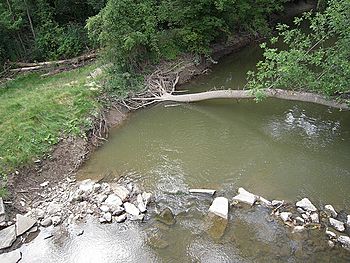Plaster Creek facts for kids
Quick facts for kids Plaster Creek |
|
|---|---|

Plaster Creek west of Kalamazoo Avenue
|
|
| Lua error in Module:Location_map at line 420: attempt to index field 'wikibase' (a nil value).
Location of the mouth within Michigan
|
|
| Country | United States |
| State | Michigan |
| County | Kent |
| Physical characteristics | |
| Main source | Gaines Township, Kent County, Michigan |
| River mouth | Grand River at Grand Rapids, Michigan 581 ft (177 m) |
| Length | 26 mi (42 km) |
| Basin features | |
| Basin size | 57 sq mi (150 km2) |
Plaster Creek is a small river, about 26 miles (42 kilometers) long. It flows through Kent County, Michigan, in the United States. This creek is a branch of the larger Grand River. Plaster Creek got its name because of a big natural deposit of gypsum found where it meets the Grand River. Gypsum is a mineral used to make plaster. On average, about 22 million gallons of water flow through Plaster Creek each day. Two old bridges that are important to history cross over this creek.
Contents
Where Plaster Creek Starts and Ends
The very beginning of Plaster Creek is called its headwaters. You can find them in Dutton Shadyside Park. This park is located at Hanna Lake Avenue and 76th Street. It's just south of a small town called Dutton in Gaines Township.
The creek then flows north for about 26 miles (42 kilometers). It finally empties into the Grand River. This meeting point is just south of Wealthy Street in downtown Grand Rapids. The area that drains water into Plaster Creek is about 57 square miles (148 square kilometers).
Animals and Plants of Plaster Creek
Plaster Creek is a special place for fish, especially salmon. Salmon travel upstream in the creek to lay their eggs. You can even see salmon as far up as Dutton Shadyside Park where the creek begins!
While it's not a cold-water stream for trout, Plaster Creek is a good home for other fish that like warmer water.
Some rare and important species live in or near Plaster Creek:
- The snuffbox mussel (Epioblasma triquetra) is an endangered species. This means it's very rare and needs protection.
- The Beak Grass (Diarrhena americana) is a threatened plant. It grows along the banks of the creek in certain areas.
Smaller Streams Joining Plaster Creek
Several smaller streams flow into Plaster Creek, adding to its water. These are called tributaries.
- Little Plaster Creek
- Maple Creek
- Silver Creek: This stream used to flow openly, but now it's mostly underground in a large pipe called a culvert. It's known as the Silver Creek Drain.
Trails Along Plaster Creek
There are plans to build a series of walking and biking trails along Plaster Creek in Grand Rapids. These trails will let people enjoy nature and learn about the creek.
Plaster Creek Trail - Phase I
This first part of the trail starts at Ken-O-Sha Park School. It follows Plaster Creek for about 1.2 miles (1.9 kilometers). Along the way, you'll find signs that explain things about the creek. In the spring, you can see beautiful wild flowers blooming along the creek's banks and in the wetland areas.
Plaster Creek Trail - Phase II
This part of the trail is about 1.5 miles (2.4 kilometers) long. It begins near Plaster Creek and Eastern Avenue. It goes north on the east side of Eastern Avenue, crosses 28th Street, and then heads west towards Division Avenue. This trail is not just for walking and biking. It also helps protect against floods and manages water levels.
Plaster Creek Trail - Phase III
This planned section will connect Division Avenue to Oxford Street.
Eventually, these Plaster Creek trails will connect to other bigger trail systems. These include the Kent Trails and the Paul Henry Rail Trail. This will create a large network of paths for people to explore!

